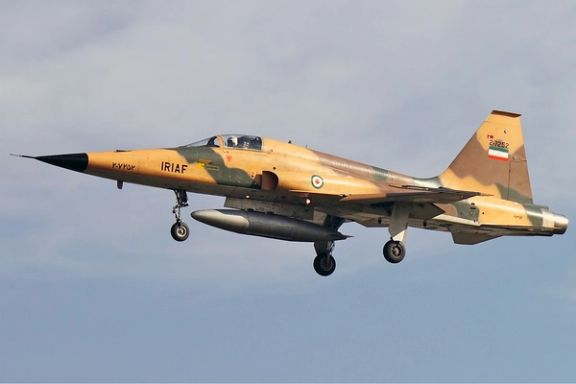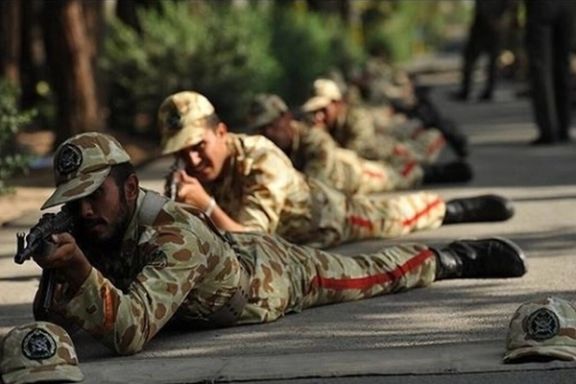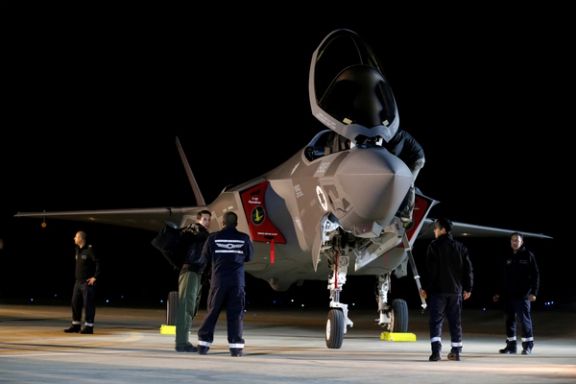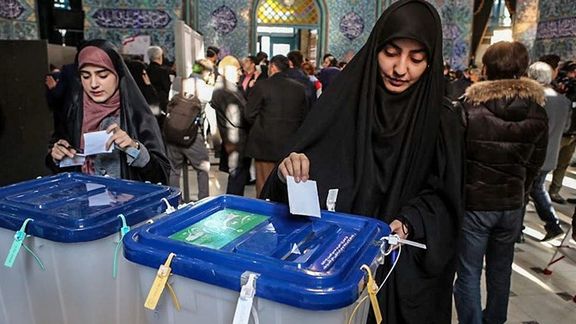Mysterious Boom In Iranian Industrial Zone Sparks Concerns

In the wake of a huge sound echoing through the industrial zone of Garmsar, officials claim the noise was merely the sonic boom produced by a fighter jet breaking the sound barrier.

In the wake of a huge sound echoing through the industrial zone of Garmsar, officials claim the noise was merely the sonic boom produced by a fighter jet breaking the sound barrier.
In a bid to calm fears, the state news agency IRNA, citing an anonymous source, reported on Monday that the “terrifying sound experienced in Garmsar was a result of the breaking of the sound barrier by a fighter jet.” The incident unfolded at approximately 9:15 local time, with the audible disturbance reaching the airspace of Garmsar, it added.
While IRNA did not disclose the affiliation of the fighter jet, the Islamic Republic of Iran Broadcasting (IRIB) referred to the aircraft as "educational" without specifying its organizational ownership.
Ahmad Rivadeh, the political, security, and social deputy of the Semnan governor, stated that the sonic boom occurred during a training flight mission. “Investigations are underway to determine the exact cause of the incident,” he claimed.
Behnam Bakhtiyari, head of the industry and mining office in Garmsar, earlier confirmed the sound of an explosion but stressed that the cause remains unknown. However, Governor Reza Khani asserted that no explosions occurred in any part of the city.
Since mid-2020, a series of explosions and fires have plagued various Iranian military, nuclear, and industrial sites, including pipelines and refineries.
One year ago, a blaze engulfed an Iranian military industrial factory in Esfahan, with suspicions pointing towards a drone strike as the cause.
Although authorities have not offered exhaustive clarifications for the incidents, they have linked several prominent sabotage attacks on facilities to Israel.

The US-based Human Rights Activists News Agency (HRANA) claims that at least 90 people were executed in the past Iranian month (December 22 to January 20) alone.
The figures mean that Iran has been catapulted to the top spot globally for the highest per capita execution rate.
The statistics show that on average, Iran carried out three executions per day throughout the past month, showcasing a disregard for the fundamental right to life within the Iranian judicial system.
Among the events highlighted in the report is the execution of Vafa Hanareh, Aran Omri, Rahman Parhazoo, and Nasim Namazi in Urmia Prison on December 29th. The prisoners faced charges of "moharebeh (War against God) and corrupting the earth through espionage for Israel."
HRANA claim that over 75% of executions in Iran remain unreported by government or judicial entities, often characterized as "secret executions" by human rights organizations.
HRANA's recent annual report also revealed a surge in executions in the wake of the 2022 uprising, sparked by the death in morality police custody of Mahsa Amini. In 2023 alone, at least 791 citizens, including 25 women and 2 child offenders, were executed, marking a shocking 33% increase compared to the previous year. Seven of the executions were conducted in public.
According to Amnesty International, from January 2012 to July 2023, over five thousand people, including at least 57 children, have faced execution in Iran.

Iran’s manufacturing industry is in decline as reports attribute plummeting sales to a substantial drop in demand hitting businesses both domestic and export markets.
According to a report by Iran's leading economic newspaper Donyaye Eghtesad (World of Economy), production-related issues such as raw material shortages and difficulties in securing foreign currency, have led to the suspension of many production units.
Soaring inflation, reduced consumer purchasing power, and a decline in demand for intermediate goods (also known as producer goods or semi-finished products), coupled with the government’s contractionary approach to the industrial sector and its interventions, have exacerbated the downturn in sales.
Highlighting the stagnation and lack of sustainable growth in the manufacturing sector, the newspaper said the government’s target economic growth rate of 8% is far from reality. Citing official statistics, the report said that the growth of Iran’s industrial and mining sector last summer was 8.7% when including the oil sector, but excluding oil, it had a negative growth of 0.4% compared to the same period the previous year. It added that the unstable growth trajectory of the industrial sector in the current Iranian year (started March 21, 2023) impacted the industrial sector's contribution to overall economic growth, decreasing from 0.8% to 0.3%.

The daily used two data sources for its analysis, a report by the Iran Chamber of Commerce on the country’s Purchasing Managers' Index (PMI) and a report by the Parliament Research Center. Examination of industrial companies listed on the stock exchange also reveals a decreasing trend in the growth index of these companies' sales, reaching the lowest point in the current season since the winter of 2021. Additionally, the production index of these industrial companies is nearly at its lowest point in the last two years, further proof of a recession in Iran's industries and manufacturing.
The Chamber of Commerce’s PMI report also revealed that weak domestic demand and a decrease in exports have led manufacturing companies to register a reduction in the Customer Sales Index (45.27) for the sixth consecutive month in December. The PMI, an index of the prevailing direction of economic trends in the manufacturing and service sectors, is based on a monthly survey of supply chain managers across dozens of industries.
The ongoing trend of reduced purchasing power and customer liquidity constraints on one side, and a decline in export sales due to the government’s inefficient regulations on the other, have led to a situation that exports cannot serve as a viable replacement to make up for weakened domestic demand, Donyaye Eghtesad noted.
According to the newspaper, economic experts argue that in addition to reduced consumer purchasing power and a a 50-percent annual inflation rate, the decline in industrial sales is the result of government interventions in foreign currency and export matters, inadequate financial support from banks for industries, and discrimination among sectors in terms of allocation of resources.
Abbas Jabalbarghi, the Vice President of the Industries Committee of the Iran Chamber of Commerce, told the daily that “the government must refrain from interfering in the manufacturing sector." Noting that “its intervention in foreign currency regulations and rates has had a detrimental impact on production, subsequently affecting the overall economic cycle and the money supply.”
The report also underlined that analysts believe the Islamic Republic’s foreign policy and isolation from the international trade market due to various US and international sanctions have also played a significant role, further restricting Iranian industrialists.

An army conscript who killed five colleagues in the squad room while on duty in Kerman barracks, has been apprehended near Zarinshahr county, officials say.
Naser Farshid, commander of law enforcement in Kerman province revealed that “the apprehended soldier was found in possession of two Kalashnikov rifles and six magazines containing a total of 180 rounds.” His motive is currently under investigation.
Citing the Islamic Republic Army, Tasnim News Agency has released the names of the five conscripted soldiers who lost their lives in the shooting.
The incident follows earlier reports in Iranian media about soldiers resorting to violence against their comrades or military authorities during their service. The motives behind such incidents are not officially disclosed by the military authorities of the Islamic Republic.
In a similar incident last year, a soldier in a barracks in the city of Deylam killed four other soldiers after taking them hostage. Iranian media attributed the soldier's motives for the killings and hostage-taking to not having been allowed to take leave.
Military service in Iran, known as "compulsory military service," is obligatory for all Iranian men above the age of 18, with certain exemptions. The mandatory 21 to 24-month service has faced criticism due to the physical and psychological pressures on soldiers, sometimes leading to outcomes such as suicide or violent acts.

Israeli air force bases hosting advanced warplanes should be the target for Iran and its proxies to attack, a conservative newspaper in Iran said on Monday.
Khorassan newspaper carried an article by Hamed Rahimpur arguing that Israel seems eager to go after valuable targets affiliated with Iran and its allies and therefore, the Tehran needs to establish deterrence and pose a credible threat.
In recent weeks, Israel is suspected of targeted airstrikes that have killed several high-ranking Revolutionary Guard officers and top operatives of Iran’s ally, the Lebanese Hezbollah and Hamas.
The successful campaign has put the Iranian regime in an awkward position of either tolerating the Israeli attacks or retaliate and risk a wider war. Iranian officials have been saying that one aim of the Israeli campaign is to draw Iran into a war, and this should be avoided.
"When an enemy makes a final decision to eliminate someone, sooner or later, they will act on their decision,” the article said and continued that the key issue is to be able to change the enemy’s calculus in predicting Iran’s response.
Khorassan newspaper suggested that Iran or its proxies should focus on attacking Israeli airbases hosting the F-35 advanced fighters to present a credible deterrence to further attacks on their valuable assets. The newspaper mentioned bases in Eilat, where it said Iran’s proxies have tested the feasibility of strikes, presumable with missiles.
Iranian-backed militia last week retaliated against a US base in Iraq after five of its IRGC officers were killed in an airstrike in Damascus, Syria.

With all the talk about Iran's fate in a possible escalation of war in the region, the parliamentary election on March 1 is not the foremost concern for Iranians.
Besides immediate fears of war and conflict, Iranian media also highlight expectations of a low turnout amid a general indifference to the regime’s highly manipulated elections.
Nevertheless, Iranian media are passionately discussing what the election might hold for Iranians, although almost all of them are quite sure that ultraconservatives will win the majority of seats in the parliament (Majles).
Reports in the reformist media alternate between the news of fresh divides and new alliances in the conservative camp. Arman Melli, a reformist daily, wrote last week with a high degree of certainty that "Conservatives are unlikely to reach unity."
The daily argued that although it is too early to predict what will happen in the conservative camp, the dynamics among conservative groups indicate that there is a likelihood of an alliance, and it is almost certain that Majles Speaker Mohammad Bagher Ghalibaf's name will be at the top of the conservatives' list of candidates.
This comes despite Ghalibaf not being the most popular figure among Iranian conservatives, as even members of the parliament have lately criticized him harshly for his inaction and his failure to establish the parliament's supervisory role.
Yet, the daily speculated that there are more signs in the conservative camp indicating divides among various groups. Arman Melli wrote that the sheer number of various groups is more indicative of divides than alliances. The daily noted that all conservative groups in Iran believe that unity is something good only if they are the leader of the alliance. This is what can easily turn the illusion of an alliance into solid signs of divide.
Another pro-reform daily, Arman Emrooz, wrote on January 16 that an alliance is likely to be formed by conservative groups, led by the hardliner Paydari Party, which holds the majority in the current Majles and most of the cabinet ministers of the Raisi Administration are its members. The daily argued that accepting Paydari's leadership is the only condition that can bring about an alliance among Iranian conservatives.
Arman Emrooz added that key conservative figures such as father figure Gholam Ali Haddad Adel and Assadollah Badamchian of the Islamic Coalition Party have already agreed that Paydari should lead other conservative parties and political groups. Although the two men are influential enough, but other conservative groups have still not voiced their views about Paydari's leadership.
Badamchain has recently said that his party has 200 candidates for constituencies all over the country. It appears that there is currently an agreement among conservatives that Paydari should continue to hold the majority of the Majles under the speakership of current Speaker Mohammad Baghert Ghalibaf. This was the arrangement that was first made after the current Majles convened for the first time in May 2020. Ghalibaf does not have a big number of followers in or out of the parliament, but despite essential differences, even Paydari agrees that as a relative of Supreme Leader Ali Khamenei, Ghalibaf can be a good leader for the Majles, and his kinship ties gives him the leverage to resist pressures coming from the executive branch.
However, Ghalibaf has powerful rivals in the internal election for choosing a speaker. Paydari's Leader Sadeq Mahsouli, and the Chairman of its Central Council Morteza Aqa Tehrani have always been serious competitors for the post. In the next Majles, there is a true conservative heavyweight Ghalibaf and others need to tackle: Mohammad Reza Bahonar. Even hardliner Mohammad Hossein Naqavi Hosseini says Bahonar stands way higher than others in the competition for the post of the speaker of the parliament.
The only thing that can stop Bahonar, a seasoned politician and a former Vice Speaker, from rising to the position of Speaker is a sold alliance among other conservative groups, Naqavi Hosseini said.